Choosing Dental Floss
Have you ever stood in the supermarket aisle feeling confused? Which dental floss should you use?
In this article, Oral Hygienist Ms. Tan and Dr. Hong explain the various options you can consider.
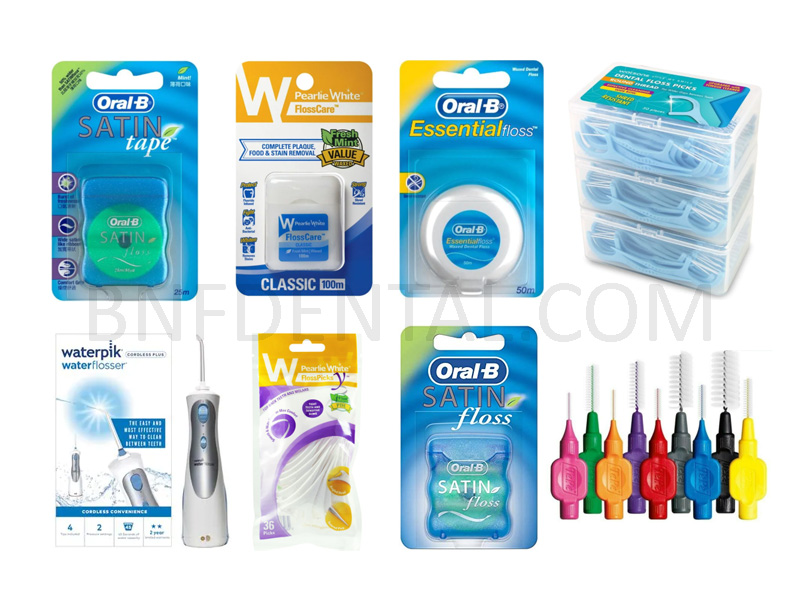
What is Dental Floss For?
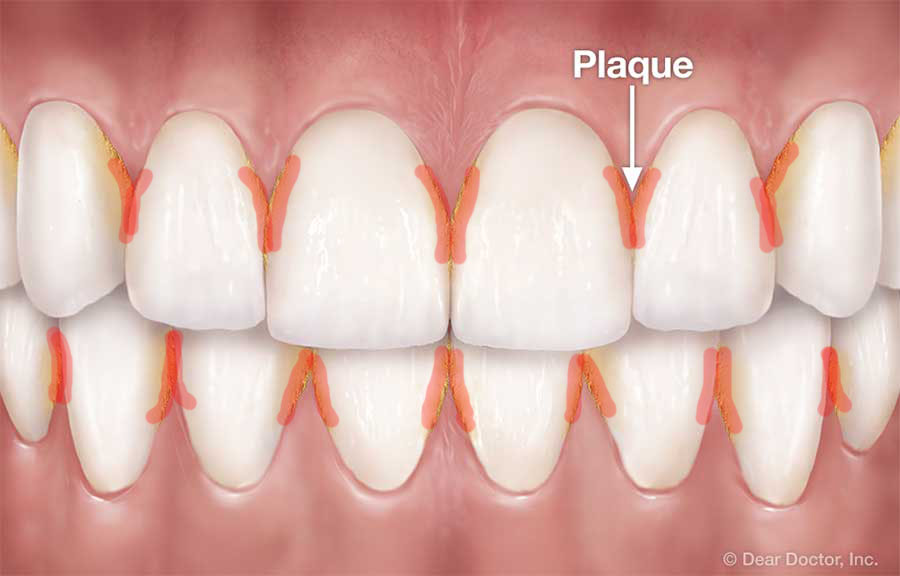
Dental Plaque Between Teeth Is Hard to Brush!
Dental Plaque is the soft mushy stuff that sticks to your teeth. “It is a sticky colorless deposit at first, but when it forms tartar, it is often brown or pale yellow. Bacterial plaque is one of the major causes for dental decay and gum disease.” – source: Wikipedia.
Your toothbrush is limited to pressing and scrubbing on surfaces, but may not be able to squeeze between teeth to clear the gaps well.
How do you clear the gunk out?
Specialized Teeth Cleaning Devices help us do this!
1. Dental Floss
2. WaterPiks and other Oral Irrigator Devices
3. Interdental Brushes
All these tools are used to solve one problem which is to clean BETWEEN Teeth - Interproximal Cleaning!
1. Dental Floss
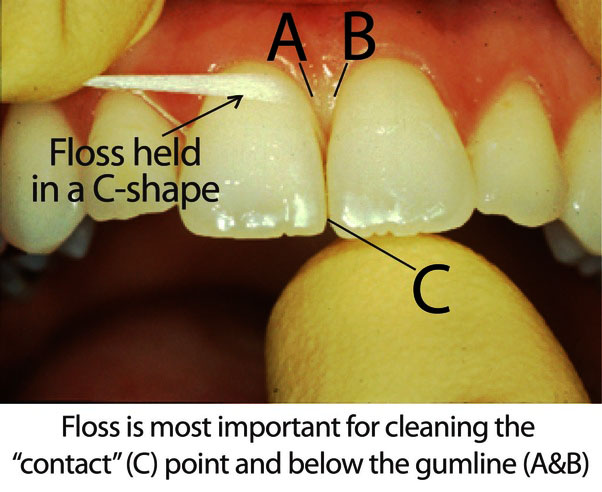
A. What is Dental Floss?
Dental floss is a cord of thin filaments that is used to clean between teeth in the places that the toothbrush does not reach.
B. What Types of Dental Floss are there?
Dental Floss is usually made of nylon. The floss string can be waxed (for ease of gliding through the gaps) or unwaxed.
There are String forms and flatter Tape forms also. They can be made of multiple strands of fibres or a single strand.
Floss can come with pre-fabricated handles (Floss Picks) and can be used with devices such as Floss Threaders to clean between fixed dental bridges (where there are no gaps between the teeth.
C. How Do I Choose Dental Floss?
Our Dental Hygienist Ms. Tan Hui Shan says:
There are several types of floss commonly available:
1. Waxed Thin Floss – I recommend this for beginners to kick-start their flossing habit.
– Usually flavored and thicker than unwaxed thin floss.
– Good for tight / crowded teeth contacts
– Shred-resistant and glide easily between teeth.
– May have some artificial flavoring which may be a con for some people.
2. Unwaxed Thin Floss – (Unflavored) – I recommend this for users who have gotten their flossing methods perfect to a pat!
– Great for tight teeth contacts with smaller gap and crowded teeth.
– Because they have no wax, they will squeak against clean teeth, indicating that plaque has been removed!
– They are chemical-free with no artificial flavor.
– However, they can tear or shred easily.
3. Dental Tape – broader and flatter floss
– These are great for well-aligned teeth or widely spaced teeth.
4. Floss Picks with Holders (Y-shaped or Knife-shaped)
These are great for patients with small mouth openings who have difficulty reaching their back teeth. They also work better for patients with compromised dexterity.
5. Super Floss – a thinner leading floss section to thread between tight areas and a thicker furry body to clean between wider gaps or under fixed dental work / appliances. These take some getting used to but can be very useful in certain cases such as for bridges, fixed implant work or braces.
Regardless of the type of floss, they generally do the same thing and are used the same way. They are used to sweep between teeth.
For my personal preference, I like Waxed Floss or Dental Tape. I find that there are some brands of floss that disintegrate easily when in contact with water and I try to avoid those. Generally, the best floss is the floss that you use on a daily basis!
D. How Do I Use Floss?
2. WaterPiks and other Oral Irrigator Devices
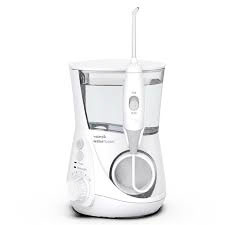
A. What is an Oral Irrigator Device?
An oral irrigator (also called a dental water jet, water flosser or, by the brand name of the best-known such device, Water Pik) is a home dental care device which uses a stream of high-pressure pulsating water intended to remove plaque and food debris between teeth and below the gum line. Regular use of an oral irrigator is believed to improve gingival health. The devices may also provide easier cleaning for braces and dental implants. – Source: Wikipedia
B. Are Oral Irrigator Devices better than Flossing?
The jury is still out on whether oral irrigator devices are better than flossing. However, many studies have shown that these devices are shown to reduce bacterial count in gum pockets and improve gum health. They are also extremely useful in cases where people are unable to floss. For example, in braces patients. Oral irrigation forms one part of a comprehensive effort for gum self-care and should preferably be used in conjunction with proper brushing and flossing.
C. How do I use an Oral Irrigator Device?
Here is a video on how to use the Waterpik, arguable one of the best-known oral irrigator devices. The instructions may not apply to different irrigator devices and brands.
3. Interdental Brushes
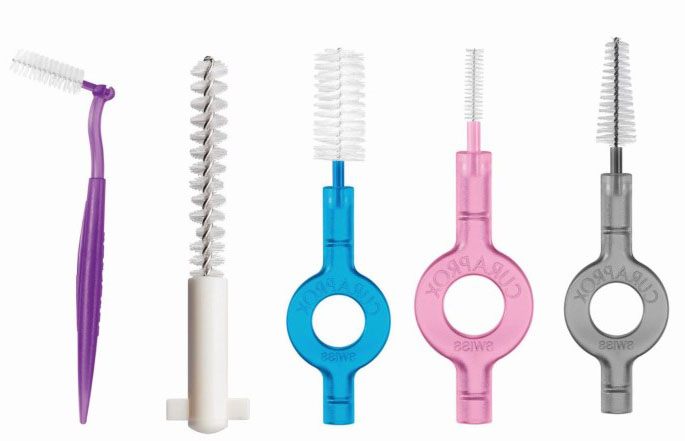
A. What are Interdental Brushes?
Interdental brushes commonly consist of a central metal wire core with soft nylon filaments twisted around and are available in various sizes to correspond to different spaces between teeth. Certain factors such as material, geometry and size of the brush can be chosen to optimize the efficiency and effectiveness:
B. What types of Interdental Brushes are there? How do I pick one and how long do they last?
Interdental brushes generally come in different sizes and with different handle types. Generally a rule of thumb is to pick the biggest brush head size that can comfortably squeeze between the teeth gaps. The central wire is generally very fine and the size is mainly due to the nylon bristles that stick out, so you need not worry about the size of the brush head too much. Interdental brushes are said to last for 1 – 3 weeks with daily use, but should be changed when the bristles get dirty or worn.
Interdental brushes work well for braces and for larger teeth gaps.
C. How Do I Use an Interdental Brush?
What Type of Cleaning Method is Right For Me?

It depends on the type and size of the gaps between your teeth!
Dental floss works for most people with normal contacts between the teeth if used correctly.
People with braces or dental bridges where the teeth are stuck or joined together are unable to use floss. In such cases, they should use interdental brushes instead.
People with big gaps between the teeth can use floss, but it may be more efficient to use larger sizes of interdental brushes.
Oral Irrigators work well for braces and around dental implants, but should not be used after gum or implant surgery as you may disrupt the healing area. They can be used in most cases. We generally would not recommend the oral irrigator be used as a single interproximal cleaning device, but used as an adjunct to other devices like floss and interdental brushes.
Should I Floss / Clean between the Teeth Before or After Brushing?
There is some controversy on this and the viewpoints are:
1. Flossing before brushing: Helps to clear the plaque and allow fluoride from toothpaste to reach between the teeth.
2. Flossing after brushing: Helps to clear the residual plaque after the toothbrush has done its job.
In truth, the difference may not be significant. More importantly, flossing daily will help to keep your teeth and gums healthy!!
Can I Use Toothpicks?
We generally do not encourage toothpick use as they can be too harsh and abrasive to the sides of the teeth, making gaps wider. It is not uncommon that we see large rounded tooth-pick sized spaces between teeth that end up trapping more food over time. It is better to use floss or other gentler interproximal cleaning devices.
https://www.insider.com/are-toothpicks-bad-for-teeth-gums
At What Age Can Kids Start Flossing?
Children can start flossing gently at any age that they have obtained sufficient manual dexterity. In our clinic, we do guide children from the ages of 3 or 4 onwards to floss.
Even if they cannot do it well yet, they at least get an introduction to flossing which will help build good habits from young, and they will be more receptive to their parents flossing for them. It is also amazing how much soft plaque we can floss out from their teeth!
What Do I Do If I Floss and My Gums Bleed?
As long as you are using the recommended method of sweeping against the teeth and not sawing at the gums, it is common that inflamed, unhealthy gums will bleed. Keep going! You will usually find that the gums get healthier over the next 2 – 3 weeks and bleeding decreases. Do not give up!
Conclusion
1. Choose the type of interdental cleaning device that is best for your gum condition.
For large gum gaps and large teeth spaces, interdental brushes may work best.
For normal teeth gaps, floss should be fine.
2. WaterPiks and oral irrigation devices have their place in home care, however they are better used in conjunction with other modes of interproximal cleaning such as floss and interdental brushes.
3. It may be better to floss / clean between the teeth before brushing, but it is more important to be consistent with daily flossing / cleaning between teeth.
4. Avoid Toothpicks as they can be quite damaging to teeth and dental work, as well as make gaps wider over time!
5. Start Young - Parents can floss for young children even at the ages of 3 - 4 to ingrain good habits and then guide them to slowly floss by themselves as they gain better hand dexterity.
- By bnfdentalsg
- April 11, 2021
- 1:44 pm



